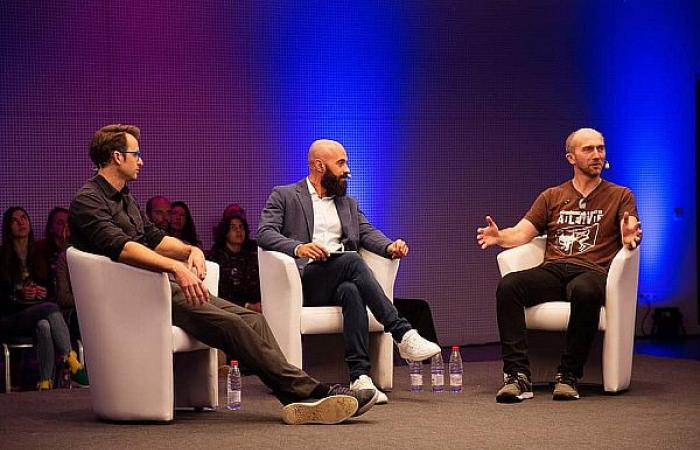This was stated in an interview with FrogNews by the famous photographer Hugh Turvey.
His work explores the borderlands between art and science. Hugh is a multidisciplinary experimenter and modern pioneer of x-ray aesthetics. Turvey, a modern pioneer in the x-ray art genre for 25 years, has witnessed the advancement of imaging firsthand and is uniquely positioned between the aesthetic photography and radiographic worlds.
On November 29, there will be an exhibition at DOZA Gallery in Sofia, in which Hugh Turvey himself will participate. The exhibition will continue until December 2. The opening on November 29 is from 7 p.m.
Here is the full interview:
To see the invisible – this is how your entire work can be described. You are taking x-ray photography. How did the idea for all of this even come about?
I never liked secrets! As a kid I used to take things apart to see how they worked. As a teenager, I was confused by the behavior of friends, so I learned all about them. At a young age, I started taking pictures to interpret the world around me. X-ray photography seemed a logical extension of my passion for photographic science – black and white film, developer, stopping, fixing, darkrooms, safety lights and the final result.
A good photographer really understands light. X-ray “light” can be controlled in a similar way. It was a new photographic medium to explore and make my own – my new visual voice. X-ray aesthetics.
But that wasn’t the plan. You wanted to be a rock and roll photographer. Is x-ray photography so different, or is it as rock and roll as possible?
It’s true, I envisioned a career as a music photographer and was lucky enough to apprentice for 4 years with Gered Mankowitz in London. He was generous enough to let me use his Old Chapel photography studio at weekends and I took portraits of friends, singers and bands. During this time I met a lot of London artists and subsequently a designer friend asked me about creating a similar “reveal” image for a band’s album cover.
We discussed skeletons and x-rays and that’s when my vision widened – my “Eureka” moment. I got a metaphysical lifetime pass backstage with x-ray access to all areas.
What is the process of creating a piece and what is the most difficult part of your job?
The x-ray image capture is 1:1 scale and I mostly use 14×17 inch film to make the images. Objects are placed on the film and exposed to X-rays and, like photograms, the object is removed to reveal an image of the object. The difference is that a photogram will create a silhouette image of a solid object, while an x-ray photogram (or Xogram as I call them) will penetrate the object and leave a shadow of the densities.
Larger objects require many sheets of film to produce, requiring stitching. Small objects in turn leave a small image on the film which can be of poor quality, and since X-rays are a penetrating form of high-energy electromagnetic radiation, I can’t be in the same room when exposing film.
What’s the hardest X-ray you’ve ever had? Which one is your favorite and why?
There are many challenges, including radiation. I have spent years perfecting very high quality images of small flora, especially used by the perfume industry to express the beauty in nature.
With a team in Germany and a production team in London, we set about creating the first animated X-ray work commissioned by Credit Suisse, the most challenging of which was bees on a honeycomb.
I pioneered an interactive educational eBook with TouchPress called X IS FOR X-RAY, which allows children to slide rotating objects between visible light and an x-ray image of 26 alphabet-related objects.
I was one of ten invited by the Android/Google Wear startup team to create a unique interactive X-ray watch face in Los Angeles called XOGRAM. National Geographic asked me if I could X-ray an elephant skull and jaw.
All of them are memorable with all the technical challenges and the final results.
Is there something you really want to x-ray?
To explore new topics and ideas over the years, I have tried a wide variety of industrial and medical imaging methods including: MRI, CT, positron emission tomography, fluoroscopy, mammography, synchrotron x-ray, microCT and ultrasound. Like all art forms that have come before, my artistic practice has been shaped and guided by advances in science and technology. So I guess the object I really want to depict is something that hasn’t been discovered yet using equipment that doesn’t yet exist.
All kidding aside – I’ve been researching photogrammetry, 3D and LIDAR to image objects that are impossible to do with conventional x-rays, but in combination with x-rays to create imaginary spaces. The current project includes a house.
It was part of the “Ratio” forum, which aimed to bridge the gap between science and art. How does your work fit into all of this?
I became the first and permanent Artist in Residence at the British Institute of Radiology in 2009 and this gave me unprecedented access to the world of radiography. BIR is the oldest radiological society in the world. As artist-in-residence, I will continue to promote to the public the aesthetics of x-ray imaging and imaging obtained from other modalities through exhibitions, workshops, talks, partnerships…

X-rays help us see beyond the visible. Do you agree that art actually does the same thing?
Physically yes. X-rays allow us to see more as we move along the electromagnetic spectrum and beyond our normal visual plane of existence. This is a real additional visual experience of the world around us. An upgrade if you will. But it could be more.
I think art and science discuss and share truth. I suppose the artist’s truth may be quite different from the scientist’s, but both work on the narrative of the human condition, where the scientist explains the truth and the artist is responsible for expressing it.
What will be the weirdest thing in 50 years?
The discovery of extraterrestrial life on Earth. And that will be us.
interview of Jessica Valcheva
Tags: Xray photography visual voice
-







